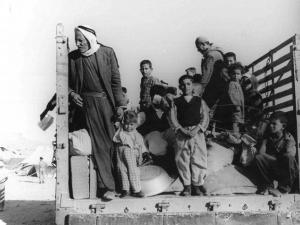Short Description
Perhaps the largest human impact of the 1948 War was the expulsion of much of the Palestinian population. Within the borders of the new State of Israel, there had been close to 1,000,000 Palestinian Arabs before the war.
Expulsion of the Palestinians
Perhaps the largest human impact of the 1948 War was the expulsion of much of the Palestinian population. Within the borders of the new State of Israel, there had been close to 1,000,000 Palestinian Arabs before the war. By the end of the war in 1949, between 700,000 and 750,000 of them had been expelled.3 Only 150,000 remained in Israel.
Refugees are always an unfortunate side-effect of war. Throughout history, groups of people had fled to escape fighting and conquest. What makes the Palestinian refugees of 1948 unique, however, is why they became refugees. Since this is still very much a real conflict today, historians analyzing the causes of the Palestinian exodus are heavily influenced by politics and international relations. Historians (including Israeli historians) have however defined a few key reasons for the exodus:
Fear: Many Palestinians left because due to fear of Israeli attacks and atrocities. These fears were not unwarranted. On April 9th, 1948, about 120 Israeli fighters entered the Palestinian town of Deir Yassin, near Jerusalem. 600 villagers were killed.4 Some died defending the city in battle against Israeli forces, while others were killed by hand grenades thrown into their homes, or executed after being paraded through the streets of Jerusalem.
Naturally, once word of this massacre spread throughout Palestine, Palestinians feared the worst from the Israelis. In many cases, entire Palestinian villages fled Israeli advances, hoping to avoid the same fate as Deir Yassin. Some Israeli groups, such as Yishuv, accelerated this feeling through psychological warfare intended to intimidate Palestinian towns into surrendering or fleeing. Radio broadcasts were aired in Arabic, warning Arab villagers that they could not stand up to Israeli advances, and resistance was futile.
Expulsion by Israeli Forces: Fear was the main motivating factor for refugees early in the war. As the war dragged on through 1948, however, deliberate Israeli expulsion became more popular. As the Israelis conquered more and more territory, their forces became more thinly spread throughout the country. As a result, many newly-conquered villages were forcibly emptied by Israeli forces.
Notable examples of this were the cities of Lydda and Ramla, near Jerusalem. When they were conquered in July of 1948, Yitzhak Rabin signed an order expelling all Palestinians from the two towns, amounting to between 50,000 and 70,000 people.5 Israeli forces bused some of them to the Arab front lines, while others were forced to walk, only being allowed to take with them whatever they could carry. This expulsion alone accounted for about 10% of the total Palestinian expulsion in 1948.
Encouragement by Arab Forces: In some cases, the Arab armies from neighboring countries, particularly Jordan, encouraged Palestinian towns to evacuate. One possible reason for this was that to provide an open battlefield without civilians in the crossfire. In any case, many Palestinian civilians left their homes under direction from Arab armies, hoping to return soon after the inevitable Arab victory, only to become refugees in neighboring countries.
After the War
The 1948 Arab-Israeli War created a massive refugee problem in the Middle East. Over 500 towns and cities throughout Palestine were completely depopulated during this time. The 700,000+ refugees from these towns became an economic and social burden on neighboring countries and the West Bank, Palestinian land under Jordanian authority. In 1954, Israel passed the Prevention of Infiltration Law. It allowed the Israeli government to expel any Palestinians who managed to sneak back to their homes in what was now Israel. It also allowed the government to expel any internally displaced Palestinians still within Israel if they sought to return to their homes.
Today, the right of return is still a major problem that has yet to be solved by peace negotiations between Palestinians and Israelis. The forcible expulsion of Palestinians in 1948 proved to be a problem that continues to last even after the lives of the original refugees draw to a close in the early 2000s.






![نصيحتي لك: اذكر الله [1 / 12] نصيحتي لك: اذكر الله [1 / 12]](https://300035.dotdothktrade.tech/images/upload/content_thumbs/1913613138ragheb-al-serjany-videos.jpg)


Comments
Send your comment